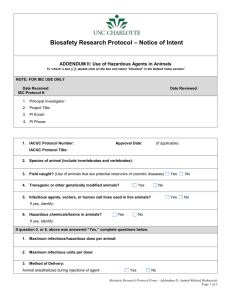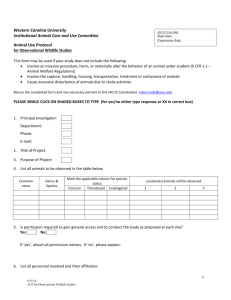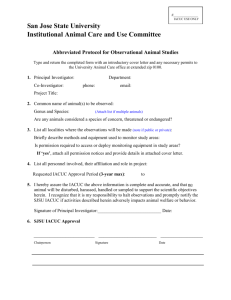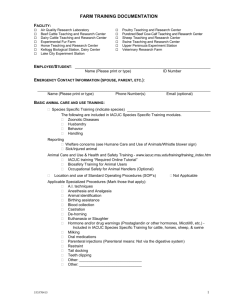The ACC Connection - University of Connecticut Health Center
advertisement
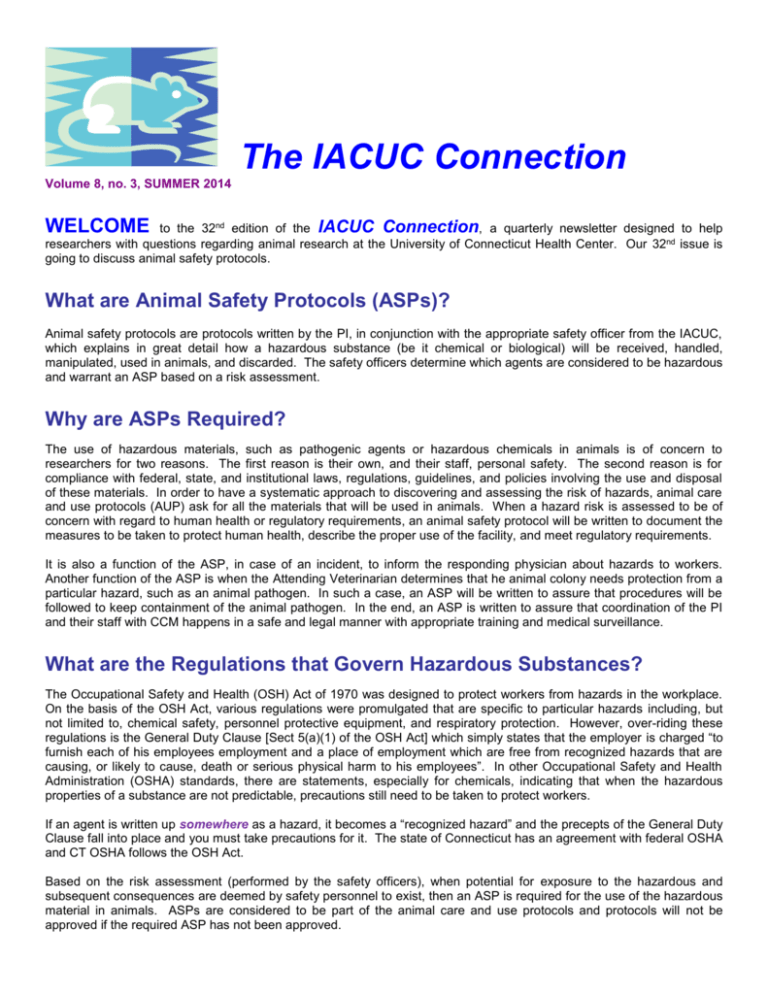
The IACUC Connection Volume 8, no. 3, SUMMER 2014 WELCOME to the 32nd edition of the IACUC Connection, a quarterly newsletter designed to help researchers with questions regarding animal research at the University of Connecticut Health Center. Our 32nd issue is going to discuss animal safety protocols. What are Animal Safety Protocols (ASPs)? Animal safety protocols are protocols written by the PI, in conjunction with the appropriate safety officer from the IACUC, which explains in great detail how a hazardous substance (be it chemical or biological) will be received, handled, manipulated, used in animals, and discarded. The safety officers determine which agents are considered to be hazardous and warrant an ASP based on a risk assessment. Why are ASPs Required? The use of hazardous materials, such as pathogenic agents or hazardous chemicals in animals is of concern to researchers for two reasons. The first reason is their own, and their staff, personal safety. The second reason is for compliance with federal, state, and institutional laws, regulations, guidelines, and policies involving the use and disposal of these materials. In order to have a systematic approach to discovering and assessing the risk of hazards, animal care and use protocols (AUP) ask for all the materials that will be used in animals. When a hazard risk is assessed to be of concern with regard to human health or regulatory requirements, an animal safety protocol will be written to document the measures to be taken to protect human health, describe the proper use of the facility, and meet regulatory requirements. It is also a function of the ASP, in case of an incident, to inform the responding physician about hazards to workers. Another function of the ASP is when the Attending Veterinarian determines that he animal colony needs protection from a particular hazard, such as an animal pathogen. In such a case, an ASP will be written to assure that procedures will be followed to keep containment of the animal pathogen. In the end, an ASP is written to assure that coordination of the PI and their staff with CCM happens in a safe and legal manner with appropriate training and medical surveillance. What are the Regulations that Govern Hazardous Substances? The Occupational Safety and Health (OSH) Act of 1970 was designed to protect workers from hazards in the workplace. On the basis of the OSH Act, various regulations were promulgated that are specific to particular hazards including, but not limited to, chemical safety, personnel protective equipment, and respiratory protection. However, over-riding these regulations is the General Duty Clause [Sect 5(a)(1) of the OSH Act] which simply states that the employer is charged “to furnish each of his employees employment and a place of employment which are free from recognized hazards that are causing, or likely to cause, death or serious physical harm to his employees”. In other Occupational Safety and Health Administration (OSHA) standards, there are statements, especially for chemicals, indicating that when the hazardous properties of a substance are not predictable, precautions still need to be taken to protect workers. If an agent is written up somewhere as a hazard, it becomes a “recognized hazard” and the precepts of the General Duty Clause fall into place and you must take precautions for it. The state of Connecticut has an agreement with federal OSHA and CT OSHA follows the OSH Act. Based on the risk assessment (performed by the safety officers), when potential for exposure to the hazardous and subsequent consequences are deemed by safety personnel to exist, then an ASP is required for the use of the hazardous material in animals. ASPs are considered to be part of the animal care and use protocols and protocols will not be approved if the required ASP has not been approved. Biological Safety Protocols Risk Assessment. The risk assessment for biologicals is performed by the Biosafety Officer and is primarily based on risk group of the agent to be used. Risk groups are based on communicability, ease of transmission (through air, direct contact, etc.), severity of disease the agent can create, and available medical treatment for that disease. This is the inherent hazard the biological agent presents. Then the opportunities for transmission of that agent during research manipulations are reviewed. For example, if one is working with an agent that can be transmissible through the air, personnel need to be careful when performing procedures that can cause aerosols. But this is not limited to agents that are transmissible through the air. Even if an agent is transmitted by direct contact, what happens when that agent is aerosolized? Potential risk = Inherent Hazard x Potential for Exposure When the characteristics of an infectious agent’s transmissibility are known, the risk group, which reflects its inherent hazardousness, can be assigned. Typically, the risk group of the agent cannot be changed (with the exception of using attenuated viruses or immunizing people to the disease the agent causes), so it can be thought of as a constant. Therefore, what the equation illustrates is that to minimize risk, what you need to do is control the potential for exposure. In order to control the potential for exposure, you perform a risk assessment using the details about the procedure provided in the AUP. Based on the AUP, preliminary risk assessments are made prior to a full risk assessment. It is important that the Biosafety Officer know what the biological hazards are and how they are being used. Generally, more information about procedures in the AUP is required before the full risk assessment can be performed. This requires an additional round of review. If all PIs wrote their animal care and use protocols with the idea of divulging all experimental details, risk assessments could be done easier and sooner. PI Writes the ASP. The PI is put through the process of detailing every procedure and its operations. The ASP is broken down into preparation of the inoculum, the action of inoculation, the housing of the animals, and waste. The PI needs to understand the process. This is important: what happens if there is a spill? There are procedures already in place if something unexpected happens. This decreases risk. This is meant to be a didactic exercise. The PI needs to look at each procedure to determine where there could be exposures. Then each instance is addressed with the point of trying to make it less likely for there to be an exposure; that is, controlling the hazard. You lower the opportunity for exposure by many ways – these can include engineering controls (such as the use of a biosafety cabinet), the use of personal protective equipment, and immunizations (if available). The Use of Biocontainment. Generally speaking, if a biological agent is a risk group 2 (RG-2) agent, it will require a safety protocol. Exceptions to this requirement are only made by the Biosafety Officer. RG-2 agents are typically kept in biocontainment, which is an ABSL-2 level facility. Exceptions to this requirement are only made by the Biosafety Officer. Biocontainment is a control. Work practices can be a control (e.g., safe practices for sharps, proper bacteriological culture techniques, etc.). Normally, biohazardous waste is processed into medical regulated waste except for the cultures themselves; these are autoclaved and then placed into medical regulated waste. Many times, there isn’t a lot of data regarding the biological agent. Precautions required by the ASPs may seem like overkill, but it is what you have to do to be safe, given the unknowns or uncertainties. And it is important to remember that just because an agent is typically transmitted by direct contact in nature doesn’t mean that it cannot be transmitted by aerosols in the lab. New Tower. In the new tower, there will be an ABSL-2 biocontainment suite. This will consist of two animal housing rooms, a procedure room, and an anteroom leading to all three rooms. Chemical Safety Protocols Risk Assessment. Risk assessments for chemical agents are performed by the Chemical Safety Specialist. They look for the potential for anyone to be exposed to a chemical that is toxic, teratogenic, mutagenic, or carcinogenic. A search for information is performed that describes the chemical agent’s effects on humans, animals, or cells. The same formula for biological risk can be used for chemical risk: Potential risk = Inherent Hazard x Potential for Exposure Again, what you are trying to do is control the potential for exposure. Preliminary risk assessments are made prior to a full risk assessment. It is important that the Chemical Safety Specialist know what the chemical hazards are and how they are being used. If all PIs wrote their animal care and use protocols with the idea of divulging all details, risk assessments could be done easier and sooner. Providing any known toxicological information regarding the chemical can be very helpful. Providing the chemical name of the agent (rather than a code name) is particularly important. This risk assessment for chemicals may be more difficult than those for biological agents because, in many cases, the inherent hazards are not known – especially for chronic, low-dose exposures. Often, metabolites of chemicals may be more or less toxic than the original chemical, so how the chemical is metabolized can be important. How a chemical is retained in the animal can be important to whether or not the animal actually needs to remain in chemical isolation for a prolonged period of time or not. If a biologically active chemical’s hazardous levels are unknown, then the chemical must be treated as potentially hazardous to comply with OSH Act. All of these considerations go into the risk assessment based on what is known about the chemical in animals and/or humans. PI Writes the ASP. The PI is put through the process of detailing every procedure and its operations. The ASP is broken down into the doses used, the solvents used, the total number of doses, the routes of administration, and the disposal of the chemical- including animal waste of those animals exposed to the chemical. The PI needs to understand the process. This is important: what happens if there is a spill? There are procedures already in place if something unexpected happens. This decreases risk. This is meant to be a didactic exercise. The PI needs to look at each procedure to determine where there could be exposures. Then each instance is addressed with the point of trying to make it less likely for there to be an exposure; that is, controlling the hazard. You lower the opportunity for exposure many ways – these can include engineering controls (such as the use of a chemical fume hood) and the use of personal protective equipment. Special Consideration for Waste Streams when using Chemicals. Knowledge of the waste stream is particularly important with regard to chemicals. One reason a protocol using a small amount of hazardous materials may require an ASP is because of the waste generated by both the use of the chemicals and the animal waste (both carcasses and bedding) of those animals exposed to those chemicals. The waste needs to be collected and disposed of as chemical waste as opposed to being discarded in an unregulated landfill. Chemical waste will generally need to be incinerated. Chemical waste that goes into an unregulated landfill can result in the leeching of the chemical into the water and soil. This can have significant long-term liability for the institution. Therefore, we need to keep chemical materials in the appropriate waste stream. The Use of Chemical Containment. Generally speaking, If a chemical is classified as a carcinogen, and FDA category D teratogen, or is acutely toxic, then an animal safety protocol is required. Exceptions to this requirement are only made by the Chemical Safety Specialist. Exposed animals are typically kept in chemical containment. Exceptions to this requirement are only made by the Chemical Safety Specialist. One practice performed at the UCHC is that if it can be determined that the maximum amount anyone involved in animal husbandry can be exposed to is less than a single human dose, then an amended safety protocol can be written. This is typically a statement of the hazards rather than a fully developed ASP. Again, this determination is only made by the Chemical Safety Specialist New Tower. In the new tower, there will be chemical isolation suite. This will consist of two animal housing rooms and a procedure room that will contain a chemical weighing station. Meet Our Biological and Chemical Safety Specialists Ron G. Wallace, Ph.D., CIH, RPB. Ron received his PhD in Molecular Biology at the University of California, Santa Barbara. He is a Certified Industrial Hygienist from the American Board of Industrial Hygiene and is a Registered Biological Professional from the American Biological Safety Association. He worked as a radiation safety specialist and a industrial hygienist before he started working in biosafety. He has over 12 years experience as a Biosafety Officer. Martin Costello, MPH, CHMM. Marty received his MPH from the University of Medicine and Dentistry of New Jersey. He is certified as a Hazardous Materials Manager from the Institute of Hazardous Materials Management. He is a member of the American Society of Safety Engineers. He has over 25 years of experience in chemical safety, most at higher education and healthcare facilities including Rutgers and Yale University, serving as an Associate Director at each institution. Frequently Asked Questions Are ASPs going to delay the approval of my protocol? It may. ASPs must be approved prior to the approval of the animal care and use protocol. Do I need to submit my ASP and AUP at the same time? No. You should not hold on to one until you can submit the other. They can undergo review sequentially or in parallel. Just be aware that final overall approval of the AUP will not occur until the ASP is approved. Does my IBC registration act as an ASP for my AUP? No. Although Dr. Wallace is involved in the writing of ASPs and IBC registrations, do not confuse the two. An AUP may precipitate both an ASP and an IBC registration. IBC registrations fulfill different compliance requirements than ASPs and are considered by a completely different committee than the IACUC. The Institutional Biosafety Committee (IBC) performs these reviews. The IBC is mainly concerned with registering the use of recombinant and/or synthetic nucleic acids at UConn Health and helps you fulfill this requirement; this is a condition of all NIH funding at the institution. Also, if an IBC registration is needed due to work in an AUP, IBC requirements must be met before IACUC approval of the AUP can be given. If you have questions you’d like to see answered in future issues, please send them to pohl@uchc.edu and we will do our best to answer as many questions as possible. Upcoming Training, August 2014 – September 2014 Initial Basic Core Training Friday, June 27 Monday, August 11 Monday, September 8 1:00 pm – 4:00 pm 9:00 am – 12:00 pm 9:00 am – 12:00 pm Building 20 conference room (LIMITED SEATS) Low Learning Center Low Learning Center PLEASE NOTE: Individuals who wish to attend training must complete a registration form and submit it to the IACUC office. Forms and instructions are located on the web at http://iacuc.uchc.edu/training/initialtraining.html. New Institutional, State, or Federal Regulations Institutional Please review all of our IACUC Policies. They are located on the web at http://acc.uchc.edu/policies/index.html. All animal users are responsible for knowing and complying with all IACUC approved policies. State None Federal None Important Reminders to Principal Investigators ۞ When an individual leaves your laboratory, and is no longer an active animal user, you must contact the IACUC Office (ooacc@uchc.edu) with this information. ۞ If any unexpected morbidity and/or mortality occurs in any experimental animal, you must contact the IACUC office (ooacc@uchc.edu) with this information. ۞ Always remember to list ALL transgenic and gene targeted animals and their origin in your animal care and use protocols. If you have any questions regarding transgenic or gene-targeted animals, please contact the IACUC office (ooacc@uchc.edu) or the Biosafety Officer (rwallace@adp.uchc.edu) for help. Next Issue: Recombinant DNA revisited CONTACTS IACUC Coordinator / Research Compliance Monitor IACUC Chair Attending Veterinarian, Director CCM Institutional Official Animal Facility Supervisor Biological Safety Officer Chemical Safety Officer TOPAZ training IACUC Office Alison D. Pohl, MS, rLATg, CPIA Joseph Lorenzo, MD Ramaswamy M. Chidambaram, DVM, Ph.D. Leonard Paplauskas Sara Fraize, rLAT Ronald G. Wallace, Ph.D., CIH, RBP Martin Costello, CIH Jim Watras, Ph.D. ooacc@uchc.edu x4129 x8199 x2731 x3173 x4075 x3781 x3512 x2896 x3429


